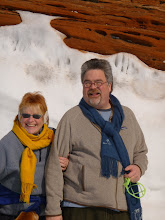Late in November I traveled with one of our project teams to Necedah, WI, home of a US Fish and Wildlife National Wildlife Refuge. This NWR is well know due to it's program of training the endangered whopping cranes to migrate to another NWR in Florida.
View Larger Map
We were there to review a schematic design for a new visitor's center to serve the many visitor's that come by to watch the training of the crane's using ultralight aircraft. The "flight" training occurs throughout much of the summer and fall, but at this time the facilities available for groups to observe this are very limited. A design had been prepared by another consultant, but due to contractual changes we will be (hopefully) carrying out the construction documents.
As luck would have it, the Aldo Leopold Legacy Center in Baraboo, WI was having a tour of their new Platinum LEED-NC building on one of our nights in the area, so we made a trip down with the folks from USFWS. A very interesting building that has great performance metrics, but also has some usability flaws, too. I think the biggest example we saw, was that ther was no parking lot lighting. Now in our climate, it can be pitch dark at 5 pm so if there was any idea of having evening programs (and this was one) this was a big safety item. The gravel driveway and slopping site made it a bit tricky. There was an attemp to install thouse little solar powered landsc ape lights, but with low sun hours and cold affecting the batteries, the car that was brought up to the building to shine it's headlights on the walkway was a welcome enhancement.
Quickly, the HVAC system was a bank of water to water heat pumps serving a radiant heating and cooling slab. A same high quality air handling unit served the ventilation air through an earth tube intake system and displacement supply grills into the occupied space. Also lots of areas that were put into "cold" storage for the winter months. There are a number of these so called net zero buildings around, but it does seem that a majority of them are low energy density (say classroom or interpretive) seasonal use buildings. Not a full blown commercial office or institutional building with at lease 2080 hours of near full occupancy and computers. Frustrating to me that there is use of the term net-zero without mentioning the seasonal use. This was the case with a NZE case study presented at Greenbuild this year.
Subscribe to:
Post Comments (Atom)


1 comment:
You write very well.
Post a Comment